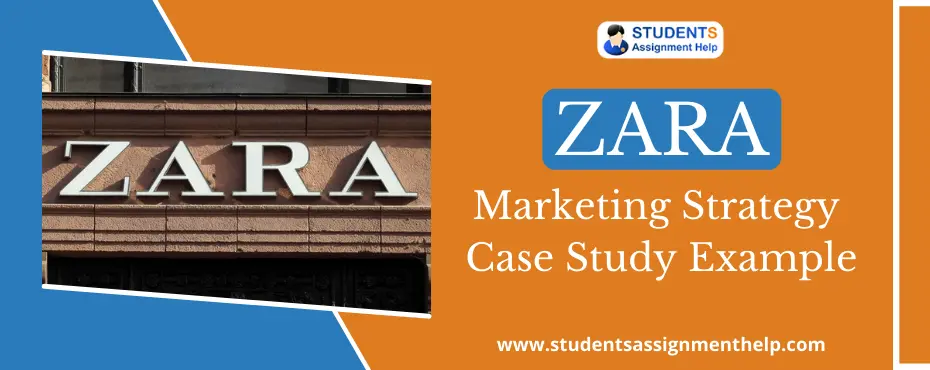Zara Marketing Strategy Case Study Example

Rosalía Mera and Amancio Ortega founded Zara in Galicia, a city in Spain. The first store manufactured and sold look-alike fashionable dresses of high-. It gradually gained popularity and reputation amongst Spanish customers and opened nine stores in notable cities in Spain.
Flexible Rates Compatible With Everyone’s Budget
Hire a Professional Essay & Assignment Writer for completing your Academic Assessments
The next decade witnessed a rapid expansion of Zara in the markets of Mexico, the US, Norway, Belgium, Israel, Cyprus, Portugal, Sweden, Malta, and France. Zara is the second-largest retailer chain all across the world. It operates more than 200 stores across 97 nations.
Amancio Ortego, the proprietor of Zara is ranked among the sixth richest men in the universe.
Competitive advantage in the Marketing Strategy
These are the factors that give clothing a competitive edge in the market.
- Strong Parent Industry: Inditex, the parent company of Zara flaunts a portfolio of eight brands that enables the brand to nurture each brand with skills and expertise and a strong financial capacity.
- Turnaround Time (aka TAT): When compared to its competitors Zara makes new products accessible to the market within 14 days of launch. The average turnaround time of the industry varies from three to six months.
- A strong presence in the parent country: As per resources, Zara generates 60% of its revenue from European countries, of which more than 18% of revenue comes from Spain.
- Store Locations: Most important aspect in terms of profitability in the apparel (retail) industry is the location of stores. Zara, the global costume retailer has its outlets placed strategically in the major cities. Total advertising expenses incurred by the company are less than that of its competitors.
BCG Matrix in Marketing Strategy
Zara deals with products like accessories and clothes for men, women, and kids. Among the three series of products manufactured by Zara
- Product lines in the women’s segment are a star.
- Men’s segment products are a star too. Though there is tough competition, there is a high demand for the products in the market.
- Product lines in the kid’s segment are a question mark, as there are many brands that are more popular for kid’s clothes.
Zara’s Brand Equity
With a market share of 10.7 billion dollars, this retail fashion business enterprise ranks among the top 53 most valuable brands all over the world.
Buy high-quality essays & assignment writing as per particular university, high school or college by UK, USA & Australian Writers
Distribution Strategy of Zara
Starting from designing to the distribution of costumes, and other products through 2100 plus stores, ara follows a strategy to run the business. As mentioned before, it makes new products available in the retail stores within two weeks of the launch.
Apart from exclusive stores, the fashion industry giant also tied up with retail stores that sell branded products. It’s helping the company to penetrate the popular cities of the nations globally.
Competitive analysis in Marketing Strategy
The fashion retail industry is highly competitive and has companies like Gucci, H&M, and Mango. National and international brands that are competing with each other in the same sector. To retain its market position and loyal customer base, Zara designs and manufactures costumes based upon consumer feedback.
Zara’s supply chain gives it a competitive and.
Vertical Integration of Zara
Things that make Zara stand out from the rest is that it’s a vertically integrated retailer company. It implies that its manufacturers distribute and the products themselves.
Vertical Integration strategy seems to be working for the brand as it could establish itself as a successful Spanish retail fashion store. It has a presence in over 30 countries including India. It’s still in a growing phase.
Product in Marketing Mix
The fashion retail brand can respond fast to the changing needs of the consumers. One of the major strengths of the company is that it manufactures its products. So, it is in full control of the manufacturing process.
The team of customer designers dedicates itself to creating the latest trends. In most cases, newly launched products are available within two weeks. In case a product fails to attract customers, it’s pulled off from the stores.
Pricing in Marketing Mix
As the concept of Zara is to sell its products at a reasonable price. Customers are more likely to find their prices affordable. Keep in mind, that customers will compare the rates and product with that of Hugo Boss.
While some of its stores are on the high end of price, most of the stores are quite affordable. Zara’s premium pricing strategy is made possible by optimizing training costs and development.
Promotional Strategy of Zara
Zara follows a low-cost or no-cost marketing strategy. The retail industry giant invests most of the time, resources, and money in opening new stores. The brand figured out things that matter to the customers.
It helped the company to differentiate itself from its customers. In simple terms, marketing strategy is based on its exclusivity, differentiation, experience, and affordability.
Stuck with a lot of homework assignments and feeling stressed ?
Take professional academic assistance & Get 100% Plagiarism free papers
